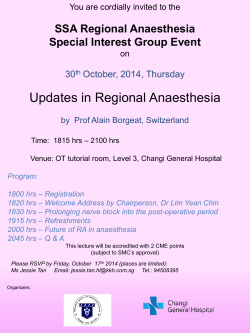
Plated Hepatocyte Relay Assay (PHRA) for the estimation of intrinsic... metabolite profile of slowly metabolized compounds
Plated Hepatocyte Relay Assay (PHRA) for the estimation of intrinsic hepatic clearance and metabolite profile of slowly metabolized compounds In Vitro ADMET Laboratories, LLC Albert P. Li,* Chi-Chi Peng, Utkarsh Doshi, Chandra Prakash, In Vitro ADMET Laboratories (UD, APL) and Biogen Inc. (CCP, CP) On day 2, the incubation medium from day 1 is transferred to a new culture of human hepatocytes prepared from the same lots used on day 1 followed by another 24 hr of incubation (1st relay). The process is repeated on days 3 (2nd relay), 4 (3rd relay), and 5 (4th relay). With this novel relay method, a chemical can be evaluated for metabolism by human hepatocytes for up to 5 days. Data Analysis: Compounds’ parent accurate mass was used to do quantification. Peak area was normalized by internal standard. Concentration after each relay was corrected for loss of drug in plated hepatocytes post-pooling according to Li Di’s paper. Percent remaining at each time points were compared to that of Time 0. Following equations were used to calculate the CLint and Clh. CLint = ln2*(1/T1/2 min)*(mL incubation/0.5 Mcells)*(120 M cells/g liver)*(21g liver/kg) = ml/min/kg CLh=Q*fu*Clint/(Q+(fu*Clint), (fu=1;human Q (ml/min/kg): 21). 3) The supernatants (150 µL) were transferred to a new plate and injected to HPLC coupled with AB Sciex triple TOF 5600 system 3) Incubate for 24 h Day 2 (1st Relay) HPLC system 1) Thaw fresh vials and plate hepatocytes to prepare the first relay plate (Plate 2). 2) T= 24 h: Pool the media containing the same chemical in all the wells in Plate 1. Remove aliquots for LCMS analysis. HPLC column Waters Acquity System Time Flow Rate Waters Corp. (Marlborough, MA) (min) (mL/min) 0 0.45 95 5 0.2 0.45 95 5 3 0.45 10 90 3.5 0.45 10 90 3.6 0.45 95 5 4 0.45 95 5 Acquity, UPLC BEH C18 1.7 µm, 2.1 x 50 mm Waters Corp. 3) Replace medium in Plate 2 with the pooled medium for the 1st Relay (T= 24 to 48 h). Incubate for 24 h. 4) Repeat procedures for Days 3 (2nd Relay; T=48 to 72 hr). 4 (3rd Relay; T=72 to 96 h) and 5 (4th Relay: T= 96 to 120 h) Column temperature 55°C Mobile Phases: A. 0.1% formic acid (ESI +) or 10 mM ammonium acetate, pH 6 (ESI -) B. Acetonitrile (ACN) A (%) B (%) Results Slope: -0.1464 ± 0.007113 4 3 2 1 0 0 10 Time (hrs) 20 30 Clozapine 5.0 Slope: -0.03504 ± 0.004935 4.5 4.0 3.5 3.0 2.5 6 4 0 20 Time (hrs) 40 60 Glimepiride Slope: -0.2179 ± 0.02527 2 0 -2 10 20 Time (hrs) 30 5.0 Ln(% of Parent Remaining) 5 Meloxicam Slope: -0.01527 ± 0.0009626 4.5 4.0 3.5 3.0 2.5 2.0 0 50 100 Time (hrs) 150 3 2 1 0 0 50 100 Time (hrs) 150 Riluzole 6 Slope: -0.09326 ± 0.003895 4 2 0 -2 20 40 60 0 Time (hrs) CLh (ml/min/kg) in vitro Clnonrenal, blood (ml/min/kg) in vivo 4 6 8 10 Risperidone 12.3 7.75 5.16 Clozapine 2.94 2.58 2.9 Glimepiride 18.3 9.8 1.12 Meloxicam 1.29 1.2 0.12 Tolbutamide 2.15 1.96 0.31 Riluzole 7.84 5.7 2.05 Ziprasidone 10.2 6.9 CL: 11.7 Diclofenac 49.8 14.8 7.67 Ibuprofen 25.7 11.6 1.5 -2 Ziprasidone 5 Slope: -0.1213 ± 0.001862 4 3 2 1 0 0 10 Time (hrs) 20 30 Ibuprofen 4 Slope: -0.3064 ± 0.02053 3 2 1 0 2 4 6 Time (hrs) 8 Clozapine, riluzole only first 48 hrs data Ibuprofen in “–” mode, no IS normalization Incubation volume: 0.1mL 10 Conclusions Summary The Plated Hepatocyte Relay Assay (PHRA) was validated with 10 model drugs with in vivo hepatic intrinsic clearance ranged from 0.081 mL/min/kg (warfarin; slowly metabolized) to 7.67 mL/min/kg (diclofenac; rapidly metabolized). Linear time-dependent parent disappearance was observed, with the calculated hepatic clearance values falling comparable to the known in vivo values. 2 5 0 Compound CLint (ml/min/kg) in vitro 2 Time (hrs) Slope: -0.02568 ± 0.0008154 4 Slope: -0.5954 ± 0.04002 4 Tolbutamide 5 Diclofenac 6 Ln(% of Parent Remaining) Risperidone Ln(% of Parent Remaining) Methods: Plated Hepatocyte Relay Assay (PHRA): The relay assay consists of firstly culturing plateable cryopreserved human hepatocytes (pooled from four donors) on day 1 for approximately 4 hrs to allow attachment, followed by incubation with the chemicals to be evaluated for a 24 hr. period. 2) Samples were vortexed and centrifuged at 3220 g (Eppendorf centrifuge) for 10 minutes. Ln(% of Parent Remaining) Materials: Plateable Cryopreserved Human Hepatocytes (IVAL, Columbia, MD): Pool of hepatocytes from four donors – HH1007, HH1023, HH1031, and HH1036 Collagen Coated 96 well plates (CellAffix™; APSciences Inc., Columbia, MD) Universal Cryopreservation Recovery Medium (UCRM; IVAL) for the recovery of cryopreserved hepatocytes Universal Primary Cell Plating Medium (UPCM; IVAL) for the initial plating of the hepatocytes Hepatocyte Incubation Medium (HQM; IVAL) for assay 2) T= 0 hr: Replace medium to that containing chemicals to be evaluated (remove an aliquot as no hepatocyte control) Ln(% of Parent Remaining) Materials & Methods 1) Supernatants (200 µL) were thawed at room temperature. Ln(% of Parent Remaining) To overcome this challenge, a relay long term metabolism assay has been developed with primary cultured hepatocytes. Sample Treatment and LC/MS Analysis 1) Thaw and plate human hepatocytes (Plate 1) and allow 4 h for attachment Ln(% of Parent Remaining) The evaluation of metabolic fate and estimation of in vivo intrinsic clearance of these “slowly metabolized” compounds is a technical challenge, as in general, little metabolism can be observed using the routine short-term incubations with human liver microsomes, S9, or human hepatocyte suspensions. Day 1 Ln(% of Parent Remaining) The current practice of metabolic stability screening of new chemical entities (NCE) has led to the collection of chemicals that are resistant to metabolism by in vitro metabolic experimental system such as human liver microsomes and human hepatocytes. Procedures Ln(% of Parent Remaining) Introduction Introduction The results suggest that PHRA can be used for the estimation of in vivo hepatic clearance of slowly metabolized compounds that cannot be readily evaluated using routine methods. The assay can also be used for the metabolite profiling and phenotyping of slowly metabolized compounds. *Corresponding author: Albert P. Li (lialbert@invitroadmet.com) ISSX - JSSX 2014
© Copyright 2025











